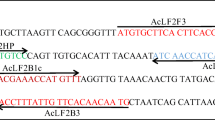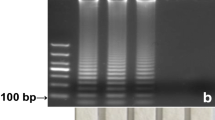Abstract
Harmful algal blooms frequently occur in various coastal regions worldwide, deteriorating marine ecology and causing huge economic losses. Therefore, developing a potential method for rapid detection of harmful algae species is highly necessitated. In this study, a loop-mediated isothermal amplification (LAMP) method coupled with a lateral flow dipstick (LFD) was developed for detecting the harmful algae Karenia mikimotoi. In this method, the internal transcribed spacer (ITS) sequence of K. mikimotoi was used as the template, and the corresponding specific primers were designed by the online software PrimerExplorer V5. Biotin was labeled on the 5′ end of forward inner primer (FIP), and the LAMP reaction was performed under the determined optimal conditions of 63℃ and 60 min. The lowest concentration of K. mikimotoi DNA tested using LAMP was 3.3 × 10–1 pg/μL. Additionally, a 6-FAM-labeled probe was designed and displayed on the LFD after hybridization of the amplified product with the probe. The results demonstrated that LAMP-LFD could be a promising approach for detecting and monitoring harmful algae due to its high sensitivity and specificity.
Graphical abstract









Similar content being viewed by others
Data Availability
All data generated or analyzed during this study are included in this published article.
References
Brand LE, Lisa C, Bresnan E (2012) Karenia: the biology and ecology of a toxic genus. Harmful Algae 14:156–178
Chen B, Wang K, Guo H, Lin H (2020) Karenia mikimotoi blooms in coastal waters of China from 1998 to 2017. Estuar Coast Shelf Sci 249:107034
Chen X, Wang R, Duan W, Miao L, Chen J (2015) Rapid detection of Ulva compressa by loop-mediated isothermal amplification combined with a lateral flow dipstick. Oceanologia Et Limnologia Sinica 46:819–827
Ding W, Chen J, Shi Y, Lu X, Li M (2010) Rapid and sensitive detection of infectious spleen and kidney necrosis virus by loop-mediated isothermal amplification combined with a lateral flow dipstick. Adv Virol 155:385–389
Fukuta S, Shinro K, Keiko Y, Yuko M, Akira I, Junnichi U, Michio K, Yoshiyuki I (2003) Detection of tomato yellow leaf curl virus by loop-mediated isothermal amplification reaction. J Virol Methods 112:35–40
Furuya K, Iwataki M, Lim PT, Lu S, Leaw CP, Azanza R, ., Kim HG, Fukuyo Y (2018) Overview of harmful algal blooms in Asia. Global Ecology and Oceanography of Harmful Algal Blooms: 289–308.
Glibert P, Zhou M, Zhu M, Burford M (2011) Preface to the special issue on eutrophication and HABs: the GEOHAB approach. Chin J Oceanol Limnol 29:719–723
Guillard RRL, Ryther JH (1962) Studies of marine planktonic diatoms: i. cyclotella nana hustedt and detonula confervacea (cleve) gran. Can J Microbiol 8:229–239
Huang H, Zhu P, Zhou C, He S, Yan X (2017a) The development of loop-mediated isothermal amplification combined with lateral flow dipstick for detection of Karlodinium veneficum. Harmful Algae 62:20–29
Huang H, Zhu P, Zhou C, Yan X, Zou Y, Lv P (2017b) Detection of Skeletonema costatum based on loop-mediated isothermal amplification combined with lateral flow dipstick. Mol Cell Probes 36:36–42
Kono T, Ram S, Masahiro S, Toshiaki I (2004) Detection of white spot syndrome virus in shrimp by loop-mediated isothermal amplification. J Virol Methods 115:59–65
Li X, Yan T, Yu R, Zhou M (2019) A review of Karenia mikimotoi: bloom events, physiology, toxicity and toxic mechanism. Harmful Algae 90:101702
Lu S, Hodgkiss I (2004) Harmful algal bloom causative collected from Hong Kong waters. Hydrobiologia 15:231–238
Nagai S, Itakura S (2012) Specific detection of the toxic dinoflagellatesA lexandrium tamarense, and Alexandrium catenella, from single vegetative cells by a loopmediated sisothermal amplification method. Mar. Geonomics 7, 43–49.
Nie K, Zhao X, Ding X, Li XD, Zou SM, Guo JF, Wang DY, Gao RB, Li XY, Huang WJ (2013) Visual detection of human infection with influenza A (H7N9) virus by subtype-specific reverse transcription loop-mediated isothermal amplification with hydroxynaphthol blue dye. Clin Microbiol Infect 19:e372–e375
Nimitphak T, Kiatpathomchai W, Flegel TW (2008) Shrimp hepatopancreatic parvovirus detection by combining loop-mediated isothermal amplification with a lateral flow dipstick. J Virol Methods 154:56–60
Niu J, Jian H, Guo Q, Chen C, Wang X, Liu Q, Guo Y (2012) Evaluation of loop-mediated isothermal amplification (LAMP) assays based on 5S rDNA-IGS2 regions for detecting Meloidogyne enterolobii. Plant Pathol 61:809–819
Notomi T, Hideki O, Hiroaki M, Tohru Y, Kazuo W (2000) Loop-mediated isothermal amplification of DNA. Nucleic Acids Res 28:e63
Notomi T, Mori Y, Tomita N, Kanda H (2015) Loop-mediated isothermal amplification (LAMP): principle, features, and future prospects. J Microbiol 53:1–5
Puthawibool T, Saengchan S, Wansika K, Timothy WF (2009) Detection of shrimp infectious myonecrosis virus by reverse transcription loop-mediated isothermal amplification combined with a lateral flow dipstick. J Virol Methods 156:27–31
Song T, Toma C, Nakasone N, Masaaki I (2005) Sensitive and rapid detection of Shigella and enteroinvasive Escherichia coli by a loop-mediated isothermal amplification method. FEMS Microbiol Lett 243:259–263
Wang L, Li L, Alam M, Geng Y, Li Z, Yamasaki S, Shi L (2008). Loop-mediated isothermal amplification method for rapid detection of the toxic dinoflagellate Alexandrium, which causes algal blooms and poisoning of shellfish. FEMS Microbiol. Lett. 282, 15–21.
Zhang F, Xu Z, Ma L, Zheng J, Miao Y, Lu Y (2009) Loop-mediated isothermal amplification (LAMP) establishment for detection of Karenia mikimotoi (Dinophyceae). Acta Oceanol Sin 31:170–175
Zheng J, Zhang F, Ma L, Lu Y (2009) Sequence analysis of Karenia mikimotoi based on ribosomal 18S rDNA and internal transcribed space regions. J Shanghai Ocean Univ 18:680–685
Zhou Q, Chen X, Cai Y, Duan L, Duan W, Miao L, Chen J (2016) Development of a novel LAMP-LFD method for rapid detection of Ulva pertusa. Oceanologia Et Limnologia Sinica 47:380–389
Funding
This work was funded by the Special Foundation for National Science and Technology Basic Research Program of China (Grant No. 2018FY100207); the National Key Research and Development Program of China (Grant No. 2017YFC1404304); the Strategic Priority Research Program of the Chinese Academy of Sciences (Grant No. XDA23050302); the Sino-Australian Centre for Healthy Coasts (Grant No. 2016YFE0101500); Aoshan Science and Technology Innovation Project, Qingdao National Laboratory for Marine Science and Technology (Grant No. 2016ASKJ02-1); Foundation of Key Laboratory of Integrated Marine Monitoring; and Applied Technologies for Harmful Algal Blooms (Grant No. MATHAB201707).
Author information
Authors and Affiliations
Contributions
Han Xiaotian: supervision, conceptualization, project administration, and data curation. Zhao Ting: writing—original draft, writing—review and editing, methodology, and investigation. Yan Tian: methodology and investigation. Yu Rencheng: methodology and investigation.
Corresponding author
Ethics declarations
Ethics approval and consent to participate
Not applicable.
Consent for publication
Not applicable.
Competing interests
The authors declare no competing interests.
Additional information
Responsible Editor: Vitor Vasconcelos
Publisher's Note
Springer Nature remains neutral with regard to jurisdictional claims in published maps and institutional affiliations.
Xiaotian Han and Ting Zhao contributed equally to this work and should be considered co-first authors.
Rights and permissions
About this article
Cite this article
Han, X., Zhao, T., Yan, T. et al. Rapid and sensitive detection of Karenia mikimotoi by loop-mediated isothermal amplification combined with a lateral flow dipstick. Environ Sci Pollut Res 29, 24696–24703 (2022). https://doi.org/10.1007/s11356-021-17536-w
Received:
Accepted:
Published:
Issue Date:
DOI: https://doi.org/10.1007/s11356-021-17536-w




